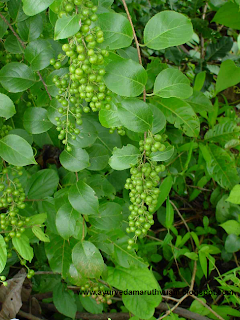KARKATA SRNGI
Pistacia integerrima/
Rhzus succedanea Linn( commercial- [AD])
Botanical Name— Rhus succedanea Linn.
Family- ANACARDACEAE
Names in different
languages
Hindi-Kakada singi; Telugu- Karkata sringi;
Synonyms—Ajasrngi, Kulira visãnikã, Vakrã, Srñgi
Scientific
classification: Pistachios make up the
genus Pistacia of the family Anacardiaceae. The pistachio, or pistacia, tree is
classified as Pistacia vera, Pistacia integerrima, and the turpentine
tree as Pistacia terebinthus.
Classification according to Caraka, Susrutha & Vagbhata
Caraka
Kãsahara, Hikkanigrahana, Madhura skañdha
Susruta
Kakolyãdi, Padmakãdi
Vagbhata –
Introduction—
Karkada is the name of the tree producing srngi (gall). People consider this tree as dreadful. It is important to note that Susruta classified it as poisonous tuber.Gall produced by the help of a insect- Dasia aedifactor – (plant produce resin against insect). Mainly effective in children’s diseases.
Varieties &
adulterants
1. Pistacia chinensis
2. Rhzus succedanea Linn(
commercial)
3. Ajasrngi ,Mesasrngi,
Uttamãsrngi ( controversial- creeper)
4. Karkatika
5. Karktahvaya
6. Karkatãkhya
Morphology
It is glabrous tree
grown unto 16m, dark grey or blackish bark.
Leaves- 20-25 cm long,
with or without terminal leaflet; leaflets 4-5 pairs, lanceolate, coriacious,
base oblique.
Flowers- in lateral
panicles; male compact, pubescent; female lax, elongate.
Fruit- drupe, globose,
dry, stony, broader than long, glabrous, rugose, grey. Seeds with a membranous
testa. (Flowers and fruits during March-April).
Distribution & Habitat
North-west Himalayas
(Indus to Kumaon) at 400- 2000 m; cultivated in Punjab plains.
Chemical composition It has 60% tanin and 1.21% volatile oil, Fresh
hirda, maiphal , tannins.
Galls— essential oils, resin, pistacienoic acids A & B, 3— sitosterol, aromadendrene, camphene, caprylic acid, cineol, a— pinene etc.
Leaves & bark— tannins.
Seeds—amino acids, dihydromalvic acid, proteins etc.
Seeds—sterals, triterpenoids etc.
Galls— essential oils, resin, pistacienoic acids A & B, 3— sitosterol, aromadendrene, camphene, caprylic acid, cineol, a— pinene etc.
Leaves & bark— tannins.
Seeds—amino acids, dihydromalvic acid, proteins etc.
Seeds—sterals, triterpenoids etc.
Drupe-oil— pistacin, pistacinin,
dihydroquercetin etc.
Rhzus succedanea
Properties—
Rasa Kasäya, Tikta
Guna Laghu, Ruksa
Virya Usna
Vipãka Katu
Karma Kapha-vatahara, vrsya, Grãhi, Dipana
External use : It is applied on swelling (edema). In pyorrhoea, gargles
of decoction is useful, Fowler’s applied on both fresh and
chronic wounds
Internal use
Digestive system it is an appetizer. carminative and
astringent in nature, thus useful and effective in anorexia, diarrhoea,
dysentery.
Respiratory system Because of its bitter and pungent taste it is
an expectorant. Helps in hiccoughs. cough and dyspnoea. It strengthens the
respiratory membrane inner lining of the surface.
Reproductive system It reduces uterine exudates: thus helps in
healing.
Temperature it is used
in fever induced by vata and kapha.
Satmikaran Being bitter and hot, it is a hitter tonic rasayan. Useful as rasayan in tuberculosis.
Important Yogas or
Formations
Shningyadi churna.
Karkatadi churna, Balachatsirbhadra, Balasanjivoni churna (Mixture of Ativisha,
Kakadshingi and Nagarmotha, Ativtsha’digestive, Kakadshingi ‘Nagarmntha.
Dhatugami.
Srotogamitva
Dosha Kaphaghna. vatashamak.
Dhatu Rasayani - rasa (fever).
Mala Purisha - constipative.
Srotas : Respiratory system - )dyspnoea and cough - specially in children). Uterus (endometrial).
Dhatu Rasayani - rasa (fever).
Mala Purisha - constipative.
Srotas : Respiratory system - )dyspnoea and cough - specially in children). Uterus (endometrial).
Age . children upto 3-4 years of age.
Indications— roga. Jvara, Kãsa-vãsa, Hikkã, Trsnã, Chardi, Aruci, Bãla
Part Used— Galls.
Dosage— Powder 4-5 g
Important research work
going on
1. CNS depressant activity
Therapeutic Uses—
(1) Vãjikarana— Karkatarni kalka should be taken with milk while consuming sugar, ghee and milk as the main diet(A.S.Ut.50).
(2) Vãtaja Kasa—Karkatasrngi powder is given
with oil as Anupãna (C.S.Ci. 18).
(3) Kãsa— Karkatasrngi powder may be licked with
ghee, sugar and honey followed by milk as Anupana (A.S.Ci.4).
(4) Kapha Chardi— Powder of Mustã and Karkatasrngi is useful (C.S.Ci.20).



